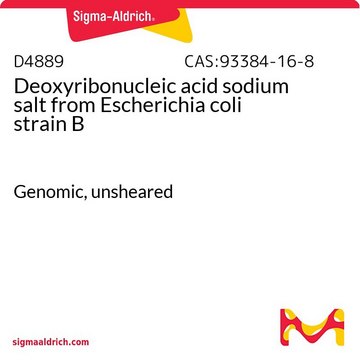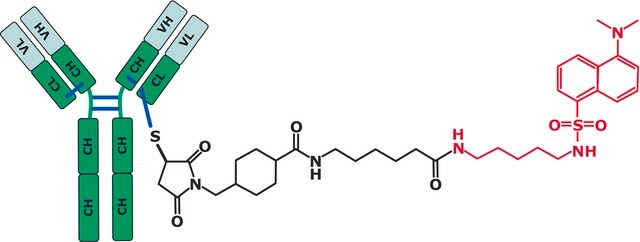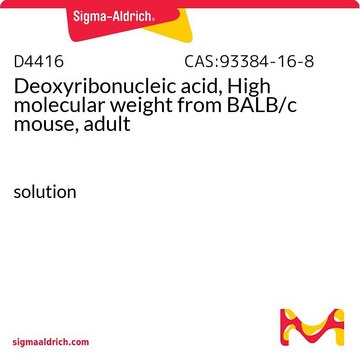D2001
Deoxyribonucleic acid sodium salt from Escherichia coli strain B
Type VIII
Synonim(y):
DNA
Zaloguj sięWyświetlanie cen organizacyjnych i kontraktowych
About This Item
Numer CAS:
Numer WE:
Numer MDL:
Kod UNSPSC:
41106305
eCl@ss:
32160414
NACRES:
NA.51
Polecane produkty
Szukasz podobnych produktów? Odwiedź Przewodnik dotyczący porównywania produktów
Zastosowanie
Escherichia coli DNA has many uses in research. Escherichia coli DNA (ecDNA) is used in studies of DNA binding agents that modulate DNA structure and function. E. coli DNA is used in physicochemical studies of DNA behavior in solution, and to evaluate species-specific DNA structures and binding domains. This DNA is particularly useful for genomic analysis, including PCR, library construction in bacteriophage lambda, and in heterologous pre-hybridization and hybridization protocols.
Deoxyribonucleic acid sodium salt from Escherichia coli strain B has been used to measure the melting temperature (Tm) and in differential scanning calorimetry (DSC) studies. It has also been used as a template sequence in the polymerase chain reaction (PCR).
Uwaga dotycząca przygotowania
Prepared by procedure of Marmur, J., J. Mol. Biol., 3, 208 (1961).
This page may contain text that has been machine translated.
Kod klasy składowania
11 - Combustible Solids
Klasa zagrożenia wodnego (WGK)
WGK 3
Temperatura zapłonu (°F)
Not applicable
Temperatura zapłonu (°C)
Not applicable
Środki ochrony indywidualnej
Eyeshields, Gloves, type N95 (US)
Certyfikaty analizy (CoA)
Poszukaj Certyfikaty analizy (CoA), wpisując numer partii/serii produktów. Numery serii i partii można znaleźć na etykiecie produktu po słowach „seria” lub „partia”.
Masz już ten produkt?
Dokumenty związane z niedawno zakupionymi produktami zostały zamieszczone w Bibliotece dokumentów.
Klienci oglądali również te produkty
R Richins et al.
Biotechnology progress, 17(2), 252-257 (2001-04-21)
The Escherichia coli DNA binding protein FIS is a transcriptional modulator involved in the regulation of many cellular processes, including the activation of rRNA synthesis. High-level overproduction of FIS in early, mid, or late log cultures resulted in growth-phase- and
William G Dundon et al.
International journal of medical microbiology : IJMM, 291(6-7), 545-550 (2002-03-14)
Infection of the stomach mucosa by the gastric pathogen Helicobacter pylori is accompanied by a large infiltration of neutrophils and monocytes which are believed to contribute substantially to H. pylori-induced gastritis. A protein was identified (HP-NAP for neutrophil-activating protein from
Geoffrey S Briggs et al.
The Journal of biological chemistry, 282(17), 12353-12357 (2007-02-20)
The DNA-binding protein, RdgC, is associated with recombination and replication fork repair in Escherichia coli and with the virulence-associated, pilin antigenic variation mediated by RecA and other recombination proteins in Neisseria species. We solved the structure of the E. coli
Mitsumasa Hashimoto et al.
The Journal of biological chemistry, 278(31), 28501-28507 (2003-05-16)
Closely opposed lesions form a unique class of DNA damage that is generated by ionizing radiation. Improper repair of closely opposed lesions could lead to the formation of double strand breaks that can result in increased lethality and mutagenesis. In
Differential scanning calorimetry of bacteria
Miles CA, et al.
Microbiology, 132(4), 939-952 (1986)
Nasz zespół naukowców ma doświadczenie we wszystkich obszarach badań, w tym w naukach przyrodniczych, materiałoznawstwie, syntezie chemicznej, chromatografii, analityce i wielu innych dziedzinach.
Skontaktuj się z zespołem ds. pomocy technicznej














